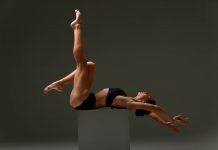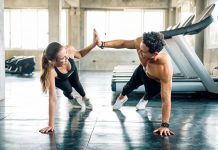Remember your first step? What a fuss everyone made! And then you continued to walk right on through childhood, adolescence, and into adulthood, but somewhere along the way, like most adults, you probably stopped walking so much.
In fact, most adults spend most of their day sitting — as many as 6.5 hours. Part of the reason may be your hectic, stressful life, with not a moment to spare for recreation or formal exercise. The environment plays a part too; inactivity has been engineered into our lives, from escalators to remote controls to riding lawnmowers to robotic vacuum cleaners to electric toothbrushes to the disappearance of sidewalks and safe places to walk. But research shows all this automation is bad for our health. Inactivity is the second leading preventable cause of death in the United States, second only to tobacco use.
You’d think a simple activity like walking would be just that, simple. However, fewer than 50% of American adults do enough exercise to gain any health or fitness benefits from physical activity. Is walking our salvation? Evidence suggests it’s probably a good start.
What are the top reasons to walk?
- Walking prevents type 2 diabetes. The Diabetes Prevention Program showed walking 150 minutes per week and losing just 7% of your body weight (12-15 pounds) can reduce your risk of diabetes by 58%.
- Walking strengthens your heart.
- In one study, mortality rates among retired men who walked less than one mile per day were nearly twice that among those who walked more than two miles per day.
- Women in the Nurse’s Health Study (72,488 female nurses) who walked three hours or more per week reduced their risk of a heart attack or other coronary event by 35% compared with women who did not walk.
- Walking is good for your brain. In a study on walking and cognitive function, researchers found that women who walked the equivalent of an easy pace at least 1.5 hours per week had significantly better cognitive function and less cognitive decline than women who walked less than 40 minutes per week.
- Walking is good for your bones. Research shows postmenopausal women who walk approximately one mile each day have higher whole-body bone density than women who walk shorter distances, and walking is also effective in slowing the rate of bone loss from the legs.
- Walking helps alleviate symptoms of depression. Walking for 30 minutes, three to five times per week for 12 weeks reduced symptoms of depression as measured with a standard depression questionnaire by 47%.
- Walking reduces the risk of breast and colon cancer.Women who performed the equivalent of one hour and 15 minutes to two and a half hours per week of brisk walking had an 18% decreased risk of breast cancer compared with inactive women. Many studies have shown that exercise can prevent colon cancer, and even if a person develops colon cancer, the benefits of exercise appear to continue both by increasing quality of life and reducing mortality.
- Walking improves fitness. Walking just three times a week for 30 minutes can significantly increase cardiorespiratory fitness.
- Walking in short bouts improves fitness, too! A study of sedentary women showed short bouts of brisk walking (three 10-minute walks per day) resulted in similar improvements in fitness and were at least as effective in decreasing body fat as long bouts (one 30-minute walk per day).
- Walking improves physical function. Research shows that walking improves fitness and physical function and prevents physical disability in older persons.
Thousands of studies have proven exercise is good for you, but exercise scientists are also looking at the other side: the negative aspects of being a couch potato.
Study after study shows sitting is not good for health or fitness. Researchers showed that people who reported sitting “almost all of the time” died sooner from cardiovascular disease than people who reported sitting “almost none of the time,” ¼, ½, or ¾ of the time, and they did so in what was called a “dose-response” manner. This means the more you sit the more likely you are to die prematurely.
One study even showed that for “every single hour of television watched after the age of 25 the viewer’s life expectancy was reduced by 21.8 minutes!”
Finally, if you’ve got a desk job, walking just five minutes per hour during every workday would help you burn approximately 33,000 additional calories per year. Provided you didn’t change your diet, the change in your walking habit could equate to a loss of body weight of 9.4 pounds at the end of the year! Considering most people gain weight as they get older, you could get a big bang for your buck with not so much effort.
What types of walking are there?
There are two types of formal walking: power-walking (also known as speed-walking) and racewalking. Both types require technique; the difference between them is that racewalking is an Olympic sport with rules, for example, that the athlete’s back toe cannot leave the ground until the heel of the front foot has touched. Power-walking is done more recreationally. Both are excellent forms of exercise that yield fitness and health benefits.
Another type of walking requires no technique; just get out there and walk, one step in front of the other! You’ve been doing it your entire life, and whether it’s for exercise, a stroll, or walking the dog, there are lots of benefits to be gained from it. Continue if that’s what you do for exercise, but if you want to up the ante and start walking faster, attention to your technique might be key.
Where can I find tips on walking techniques?
The technique for brisk walking, whether it’s power or racewalking, is the same. Below are some tips on technique.
Legwork
- A common mistake for beginners when trying to walk fast is lengthening the stride (overstriding). Overstriding is biomechanically inefficient and can slow you down. It will burn more calories because it’s inefficient (which might be a good thing), but you may burn fewer calories overall because you don’t walk as far due to fatigue.
- Instead of overstriding to walk faster, concentrate on a powerful push-off while the front foot lands closer to the body. This is what elite walkers do.
Footwork
- Walk heel to toe and not flatfooted to increase speed.
- Contact the ground with your heel.
- Roll the foot forward over the center of your foot.
- Push off with your toes.
Hips
- Rotate your hips forward and backward as you walk.
- Your waist should twist. Racewalkers can look funny because of the hip rotation but restricted hip movement decreases your speed.
Torso
- Keep your torso upright. Leaning forward or back will slow you down.
Arm work
- Keep your elbows at 90 degrees.
- Keep your hands relaxed.
- Swing your arms forward and back and keep them close to your body. Your hands should not cross the midline of your body to maintain efficiency.
- Speed up your arm swing to increase your speed and your legs will follow! This really works!
Head, neck, and shoulders
- Keep your shoulders and neck relaxed. The head should be upright, eyes looking forward.
Is walking really an effective workout?
Brisk walking can be almost as challenging as jogging because when you walk at speeds faster than 3.1 mph, your stride length naturally increases (you don’t necessarily want it to for efficiency but inevitably it happens). Lengthening your stride is inefficient because it requires additional energy to move your legs forward, which in turn requires more arm and torso movement, which leads to increased torso and hip rotation, which amounts to higher aerobic demands and more calorie-burning.
Research shows that at maximal levels of exertion, oxygen consumption (the bottom line to cardiorespiratory fitness) is only slightly lower for racewalkers than it is for runners, and at submaximal or moderate-intense levels of exercise, oxygen consumption levels between race walkers and runners are almost equal. Racewalkers can reach speeds as high as 9 mph!
What are the biomechanics and types of foot strike?
Foot strike is the term used to describe the moment your foot hits the ground when you’re walking. The normal biomechanics of a foot strike are that your heel lands first (heel strike), followed by the midfoot strike and flattening of the arch to absorb impact (very important), then the forefoot strike (front of your foot), and finally the push-off to the next stride. Soft heel strikes with a smooth gait pattern and some flattening of the arch will reduce the impact on the foot and cause less stress in joints as high up as the hip.
There are three types of foot strikes:
- Pronated foot strike. Pronation is the term to describe when your arch flattens on a foot strike (for example, when you have flat feet) and causes your foot to invert, or roll in. Excessive pronation will cause your ankle and leg to twist and can lead to stress fractures, shin splints, and other lower-extremity injuries. You’re probably a pronator if the inner edges of your shoes wear out.
- Supinated foot strike. Supination is the term to describe high arches that don’t flatten. This is a problem because if your arch doesn’t flatten and your foot doesn’t roll in at all, then you lose shock absorption on a foot strike. Excessive supination can lead to ankle sprains, Achilles tendinitis, plantar fasciitis, and iliotibial band syndrome. You’re probably a supinator if the outer edges of your shoes wear out.
- Neutral foot strike. An efficient amount of flattening of the arch is called a “neutral” foot strike. This provides plenty of shock absorption and enough energy for you to have a powerful push-off.
Health News
- How Is Autism Diagnosed?
- Simple Eye Test Might Spot Autism in Kids
- Stressed Parents Could Mean More Self-Harm by Kids
- CDC Experts Recommend Seniors Get Another COVID Shot
- Impaired Sense of Direction Could Be Early Alzheimer’s Sign
You can tell by the wear pattern of your shoes if you pronate or supinate. You can also ask a salesperson at a reputable shoe store to evaluate your gait and foot strike, or you can have your doctor or podiatrist do this. You can also try the wet test at home: wet your bare foot and then step on a piece of paper or other surface that will show your footprint. Stand normally when you do this with slight pressure toward the front of your foot. You’re a pronator if most of your foot hits the floor, a supinator if very little of your foot hits the floor, and neutral if the footprint is somewhere between pronation and supination.
What type of shoe should I buy?
Footwear for your foot type
One of the advantages of walking is that you don’t need lots of fancy equipment, but shoes can make a difference. There are many athletic shoe types to choose from: running, walking, cross-training, etc. Walking shoes typically have heels and toes that are rounded up to reduce the impact on heel strike and increase energy during push-off. Here’s how to decide what type of walking shoe to buy depending on your foot type and your foot strike.
- If you overpronate and have flat feet, avoid shoes with excessive cushioning because they lack stability and motion control. Shoes that feel as soft as bedroom slippers, lack support, or are excessively bouncy are not a good choice for over-pronators. Instead, purchase shoes with firm midsoles and pronation-control features. In addition, over-the-counter full-length arch supports for over-pronators can decrease pressure by as much as 33%.
- If you supinate and have high arches, purchase cushioned shoes that do not limit motion. Your foot doesn’t shock absorb very well if you have high arches and you supinate, and too much stability and control in the shoe will decrease shock absorption even more.
- If you have a neutral foot, you can wear any type of shoe that feels comfortable. Your foot strike is efficient with a healthy amount of arch support and shock absorption when your foot is neutral.
Important note: Speak with your doctor or consult with a podiatrist if your feet hurt. It will be difficult to stay motivated to walk if your feet hurt. Your doctor can help.
Shoe shopping basics for everyone
Some tips to follow when buying walking shoes:
- The sole of a walking shoe should be flexible with more bend in the toe than a running shoe. You will be more likely to get blisters if the shoe is too stiff. Make sure you can bend and twist the toe area of your walking shoe.
- Breathable shoes are more comfortable. Mesh fabrics are more breathable than leather, and they’re lighter, too.
- Shoes should always feel comfortable right away — there’s no “breaking in” period. Don’t buy shoes if seams or stitching can be felt. This can cause blisters, calluses, or other injuries.
- Feet swell during the day so get fitted for walking shoes at the end of the day when your feet are their largest.
- Wear the socks you normally wear when walking. Synthetic socks made of polypropylene or other synthetics are better than cotton because they don’t compress, they dry quickly, they wick moisture away from the foot, they prevent blisters, and the heel is padded. Ask at your shoe store for walking socks.
- Allow one-half inch between the end of your longest toe and the shoe’s end, with wiggle room for all toes.
- The shoe should be as wide as possible across the forefoot without allowing heel slippage. Experiment with the lacing to get a proper fit if necessary.
- Always try on both shoes before making a purchase. Buy the larger size if one foot is larger than the other.
- Replace your walking shoes when they no longer support your feet. You’ll know your current shoe is worn down if you take them to the shoe store and feel the difference when you compare them to a new pair. In general, walking shoes should be replaced after 300-500 miles.
- Find a reputable shoe store in your area to buy your shoes.
A 150-pound man burns 100 calories per mile; a 200-pound man burns 133 calories per mile; and a 250-pound man burns 166 calories per mile. You burn virtually the same number of calories whether you run or walk a mile; you just get there faster if you run. See below for a chart of calories burned during walking at different speeds and body weight.
How can people measure steps and calories burned during exercise?
Smartphone apps and wearable fitness devices are all the rage. But are they accurate?
Estimating calories burned
While wearable activity monitors are generally accurate in tracking heat rate, research shows that they can be in error an average of 27% in detecting how many calories you burn during your workout. This means that if you were to burn 300 calories during your workout, your device could be inaccurate by about 39 calories.
The devices generally rely on information on the height, weight, and age of the user combined with their algorithm to determine calorie burn. However, measuring calorie expenditure in a laboratory where temperature, humidity, and terrain (studies are conducted on treadmills) are held constant is much different than outdoors where the weather can make a big difference in how many calories you burn and so does what you wear. For instance, you burn more calories…
- when the temperature is cold compared with hot because your body works harder to keep you warm,
- when it’s humid and warm than dry and cool in an attempt to stay cool,
- when the terrain is hilly than when it’s flat because it requires more energy to climb hills,
- when you wear heavy, restrictive clothing compared with workout gear.
Wearable fitness devices and smartphone fitness apps are smart, but not that smart. They don’t add the above factors to the calculations that help them estimate how many calories you burn.
Feedback from devices can be quite useful, even if there is some error. Just don’t count on the calorie burn estimate as a precise way to decide how much to eat if weight loss is a goal.
Estimating steps
Smartphone apps and wearable devices are more accurate at estimating steps than they are at estimating calories burned. They use sophisticated accelerometers, or motion sensors, to count steps.
Even despite any inaccuracies, devices are useful. Even if there is an error, they still provide feedback which research suggests can motivate you to be more active. And if the error is consistent, at least it will tell you whether you did more or less from workout to workout.
What is a good average walking speed?
- A good average walking speed is 3 to 4 miles per hour (mph) (15 to 20 minutes per mile) and depends on your leg length and how quickly you can move your legs.
- You may need to start at a slower pace if you’re out of shape, but you will build up quickly if you walk regularly.
- Once you exceed 4 mph, it can become tricky if you don’t know whether to walk or run. Proper speed-walking techniques will help at fast speeds.
- Treadmill and outdoor walking yield the same benefits. Set the elevation on a treadmill to 1% to mimic outdoor walking.
How much walking should I do?
There are two exercise recommendations in the United States.
- The American College of Sports Medicine and the American Heart Association (ACSM/AHA) recommend 30 minutes or more of accumulated moderate-intensity physical activity on five or more days per week to improve health and fitness. “Accumulated” means you can do it in shorter bouts throughout the day (for example, 10- or 15-minute intervals throughout the day), and “moderate intensity” means you feel warm and slightly out of breath when you do it. Walking counts!
- Or, 20 minutes of continuous vigorous activity, a minimum of three times a week, at 60%-90% of maximum heart rate, and two or more days of muscle-strengthening activities. Walking can certainly be done vigorously, so go to it!
Here are some suggestions to incorporate walking into your day and accumulate 30 minutes. Think about your day and how you can increase walking.
- Get off the bus before your destination (you may even save time this way).
- Park your car farther from the store.
- Take a walk at lunch instead of having your food delivered.
- Walk for errands instead of driving short distances.
- Get rid of your riding lawnmower!
- Keep your walking shoes handy. Leave a pair at your office for quick 10-minute stress-reducing walks.
SUBSCRIBE to MedicineNet’s Weight Loss/Healthy Living Newsletter
By clicking “Submit,” I agree to the MedicineNet Terms and Conditions and Privacy Policy. I also agree to receive emails from MedicineNet and I understand that I may opt out of MedicineNet subscriptions at any time.
How do I get started?
For beginners concerned about their motivation or ability to walk far, try the “five minutes out, five minutes back” plan. Just like it sounds, walk out for five minutes, turn around, and walk back. If you feel ambitious, start with 10 minutes out, and 10 minutes back. Increase by two to three minutes per week and before you know it, you’ll be up to 30 minutes. It sounds simple, but it is a realistic and achievable way to get started, and if you follow it, you’ll be walking plenty before you know it.
Consider power-walking if you want to increase your speed. Start with your normal walking pace for five to 10 minutes as a warm-up and then try your skill at power-walking. You’ll be surprised how exhausting power-walking can be, so start with 10-15 minutes the first few times out and finish up your 30 minutes with your normal walking pace so you don’t overdo it.
Interval training
Once you reach a baseline of 30 minutes of power-walking, you can speed up even more by training at intervals. Intervals are where you set up work-to-active rest ratios (work: active rest) to push your body and improve your cardiorespiratory fitness. Here’s an example of how to do intervals:
- walk at your normal pace for three minutes, then
- increase the speed for one minute, then
- back to your normal speed for another three minutes, then
- repeat this 1:3 interval cycling for your entire workout.
- Over time, increase the work and decrease the active rest.
Here’s an example of an interval training workout for someone who walks for 30 minutes at 3.5 mph:
- walk for 10 minutes at 3.5 mph, then
- increase the speed to 3.8 mph for one minute, then
- walk again for three minutes at 3.5 mph, then
- walk again at 3.8 mph, and so on until you reach your time limit.
- Increase the work part to one and a half minutes and decrease the active rest to two and a half minutes as you get fitter (you walk faster, your heart doesn’t pump as hard, and your breathing is easier).
Your fitness will substantially improve after six to eight weeks if you continue with this type of training. You may even notice more endurance after just one or two sessions.
Stretching
The following five simple stretches can be performed before and after you walk. Ease into each stretch until you feel the tension in the muscle you want to stretch and hold until it feels looser.
Before you stretch, it is important to warm up, which can consist of a slow walk for a few minutes. When stretching, don’t bounce or hold your breath. Perform each stretch slowly and only stretch as far as you are comfortable.
Calf stretch
- Stand at arm’s length and lean against a wall or fence.
- Put one leg straight back and the other bent underneath you.
- Keep your back straight and lean your hips forward.
- Keep the rear leg straight with the heel on the ground.
- Repeat for the other leg.
Side stretch
- Stand with both arms over your head.
- Lean to one side, then the other.
- An alternative is to leave your right arm at your side and bend to the right while reaching your left arm overhead, then reverse.
Torso twist
- Stand with both arms out to the side with elbows slightly bent.
- Feet should be at shoulder width or slightly wider.
- Twist your torso to the right and then the left, alternating back and forth slowly.
Quadriceps (thigh)
- While leaning against a wall, reach back with your left hand and grab your right ankle.
- Pull your foot back and away from your buttocks.
- Repeat for the other side.
Hamstrings (back of legs)
- Put your right leg out about 18 inches from your body with your toe pointed up.
- Bend your left leg slightly.
- Reach down with both hands toward your right foot.
- Repeat for the other side.
- Alternatively, you can sit down on the edge of your bed or a park bench with one leg up and the other on the floor and reach with both hands until you feel the stretch in the back of the leg.
Planning your walks
Set a weekly plan for walking if you struggle with motivation or stick with it. Planning increases compliance. Write down the day(s) of the week you’ll walk, the time of day, how many minutes, and where you’ll do it (location). Set and review your weekly plan every week for three months and then reevaluate at that time.
Featured Centers
- What Are the Best PsA Treatments for You?
- Understanding Biologics
- 10 Things People With Depression Wish You Knew
Walking is that it can be done anywhere, such as:
- Around your block
- Your local track
- Walk your dog!
- The mall
- Mall walking is great for cold or rainy conditions and for social support and for meeting new people. Call your local mall to find out when their walking club meets (most of the time it’s before the mall opens).
- Trails in your local park
- Road races sponsored by your local running or walking club. Many running clubs sponsor walking events too, and plenty of people walk road races even when people are running. Check out your local clubs and local running stores for events.
- American Volkssport Association: A network of 350 non-competitive walking clubs that organize more than 3,000 walking events per year in all 50 states
- Rails-to-Trails: A nonprofit organization that converts abandoned railroad tracks into biking, hiking, and walking trails
- Go hiking. It’s walking in the woods! Check out the American Hiking Society for clubs in your area.
- Check out local walks for causes in your area. The American Heart Association, American Diabetes Association, and many others sponsor local walking events.
- When you travel (a great way to explore a new city)
- Architectural walking tours
Pedometers
Pedometers are beeper-sized devices that measure how many steps you take. They’re a great way to keep track of your walking progress!
Should I walk or run?
The benefits of running vs. walking
Walking is as good as jogging for both health and fitness. Many studies on exercise and chronic disease prevention use walking as the measurement. The risk of injury is low for walking, most everyone can do it, it burns calories, and it makes you fit and healthy. Jogging yields the same benefits as walking, but there is more impact on knees, hips, and other joints.
Walking for weight loss
Walking, like any other aerobic activity, burns calories and will contribute to weight loss. Of course, to lose weight, you must burn more calories than you consume no matter how much you exercise, so you must also reduce your calories if you want to lose weight, even if you’re walking a lot.
Exercise is much more important for maintaining weight than it is for losing it. Scientists believe it’s the single best predictor of maintaining weight. Research clearly shows that individuals who exercise after weight loss are far more likely to maintain their weight than individuals who don’t exercise.
As for walking specifically to control weight, walking is the most popular activity among participants in the National Weight Control Registry. The NWCR is a longitudinal study of more than 10,000 men and women who, to participate in the registry, must successfully maintain a 30-pound weight loss for a minimum of one year. The current average weight loss among the 10,000 participants is 66 pounds and the group has maintained that loss for roughly five-and-a-half years. Ninety percent of participants exercise at least one hour per day. It’s tough to argue with success!
There you have it
It’s as simple as walking out the door. And you’ll be in good company. Walking is the most popular physical activity among adults in the United States. It doesn’t take all that much time (you can incorporate it into your life), you’ve been doing it your entire life, you can do it just about anywhere, there are plenty of health and fitness benefits, and you’ll feel good once you get going. What are you waiting for? Get out there and take a walk!




























